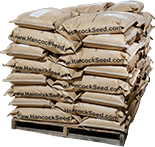Texas Tough wears its name on its sleeve, but don't think this blend is only optimum for the Lone Star State. It will take its drought-resistant, insect-resistant qualities to any state in the American South, where Bermudagrass is known to grow.
Product Information
- Application or Use: Pasture, Cattle Grazing, Livestock Forage, Cover Crop, Hay Production
- Germination Time: 7 - 14, days, under optimal conditions
- Growing Locations: Warm Season & Transition Zone
- Height: Grazing or Hay Cutting, 8 - 10 inches
- Sunlight Requirements: 8+ hours, full sun for best results
- Advantages: Economically priced alternative to Bermuda sprig varieties, offering extreme drought tolerance and minimal maintenance.
- When to Plant: Recommended planting time is spring and summer when nighttime temperatures are consistently 65+ degrees and 3 months prior to first frost.
Product Detail
- Raw seed
- Drought resistant
- Insect resistant
- Grazing and hay production
- High forage and hay yields
Product Information
Texas Tough Bermuda Grass Seed is used for pasture grazing and hay production in the warm climates and transition climates of the United States. Texas Tough is a mixture of Giant, Common and turf type Bermudagrass seed. Texas Tough was developed for its drought tolerance, insect resistance, high forage and hay yields.
Mixture:
33% Giant Bermuda (Hulled)
33% Majestic (Un-Hulled)
33% Forage Max Plus
*Product packaging may appear different than what is pictured.

When to plant: Texas Tough is a warm season forage grass, utilized for grazing or haying. Plant Texas Tough during spring and summer, when soil temperatures are consistently above 65 degrees F. The optimal soil temperature for germination and root growth of Bermudagrass is 75 to 80 degrees F.
Site Selection: Plant Texas Tough in full sun and well-drained soil in Texas and across the southern states where Bermudagrass is currently grown. Proper drainage is essential for successful establishment and the development of mature, healthy forage.
Seedbed Preparation: Loosen soil to a depth of six inches by discing. Level area to proper grade with approximately 1/2 in. pulverized soil at the surface. Prior to seeding, a soil test is recommended. Results of this test will determine fertilizer and other amendments needed. Add lime as needed to establish a minimum 6.0 soil pH.
Seeding rate for new pasture and overseeding applications: Plant 10 lbs. of Texas Tough per acre for new pasture applications. More seed may be needed when stands are established early or late in the season to ensure full coverage.
Texas Tough may be overseeded into your existing stand of Bermudagrass, such as Coastal, to improve its overall forage quality or to repair damaged areas of seeded Bermudagrass and vegetative Bermudagrass varieties. The suggested renovation-seeding rate is 5 lbs. per acre. For bare areas, use the new pasture application-seeding rate. If the turf is in very poor condition, or the damaged areas very large, total removal of the existing grasses before seeding Texas Tough is recommended, for maximum stand uniformity and overall forage performance.
When overseeding into an existing pasture, care must be taken to ensure adequate seed to soil contact. Herbicides with no soil action may be applied to eliminate any undesirable grasses before seeding. Follow label instructions for usage, and observe the required waiting period, if any, before seeding. Pastures can be aerated or disked to remove accumulated thatch areas during germination and the early establishment phase prior to first grazing or haying.
Planting: Care must be taken not to cover the seed with too much soil—no more than 1/4 in. of soil covering the seed is recommended. Effective methods include broadcasting by hand or using seed spreaders, followed by light roller or dragging. Because of the high seed count of Texas Tough per lb., the seed should be mixed thoroughly with dry sand at a ratio of 5 parts sand to one part seed, and the spreader opened only 1/16 to 1/8 in.
Soil moisture around the seed is necessary for about 1 to 2 weeks. The seedbed should be kept moist during germination. Once established, less frequent, deep moisture encourages deep root growth.
Germination: Texas Tough has very good seeding vigor. Under ideal conditions, germination begins within 7 to 10 days. Again, soil moisture is very important during the germination period. Allow 14 to 28 days after the first seedlings emerge for complete germination, fertilize per soil test once the seed has germinated.
Under ideal conditions, full coverage is attained 4 to 6 weeks after seeding and normal moisture. If planting is early or late in the season, more time may be needed for establishment.
The pasture is ready for the first cutting or grazing approximately 8 to 10 weeks after seeding, or when the grass has grown 14 to 18 inches tall. Minimum recommended mowing height is 4 in. After the first cutting for hay, mow every 28 days and add fertilizer each time.
Winter Overseeding: Winter overseeding of dormant Bermudagrass may be done for year-round pasture. It is not generally recommended on immature pasture (less than 6 to 8 months of age). Late season plantings and newly established Bermudagrass may be damaged by allowing Ryegrass to get too tall, leaving it unable to compete with the Ryegrass species during the spring transition.
Texas Tough Bermuda Grass Seed
Texas Tough wears its name on its sleeve, but don't think this blend is only optimum for the Lone Star State. It will take its drought-resistant, insect-resistant qualities to any state in the American South, where Bermudagrass is known to grow.

Instructions
For more info on planting instructions and tips for the best results – check out our Warranty & Planting Information here!
When to plant: Texas Tough is a warm season forage grass, utilized for grazing or haying. Plant Texas Tough during spring and summer, when soil temperatures are consistently above 65 degrees F. The optimal soil temperature for germination and root growth...



















